| Spectrum Software Scene |
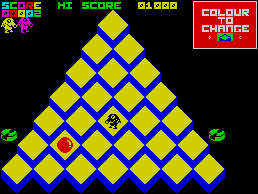
THE LATEST sequel to Pimania, Pi-Eyed and other Automata productions is Pi-Balled. Starring the Pi-man again, the story involves the mystical pyramid of Pi, the colour of which you are attempting to change by jumping from square to square while avoiding collision with two bouncing balls, Sid the Snake, the Pi-man and other hazards.
In spite of the zany presentation which has become the Automata hallmark, including a title screen crammed with grotesque leering characters, Pi-Balled is a fairly straightforward arcade game. You score points by jumping on to a square and changing its colour and you lose a life if you fall from the edge of the pyramid - which is easy to do until you become accustomed to the unusual diagonal movements required by the game - or if you land on the same square as one of the other characters. There are bonus points for every pyramid you complete and new hazards to make successive screens more difficult.
Among the original features which add appeal is a spinning disc which carries you aloft gracefully, a free ride allowed once each screen. Beware, however, of the balls which materialise at the top of the pyramid; if you choose to transfer from your disc at the time they are doing so, you will lose a life.
Pi-Balled has lively graphics - the representation of the bouncing balls is particularly convincing - and the degree of difficulty is well-judged to please both novices and more experienced players. A pop record on side two is a doubtful bonus.
| PI-BALLED | Memory: 48K | Price: £6.00 | Joystick: Kempston | Gilbert Factor: 7 |
SOFTWARE written for other machines usually loses some of its essence in translation to another machine. That is not true, however, of Laser Zone for the Spectrum. It is by Jeff Minter and was written originally for the Commodore machines.
The game revolves around a grid, called a zone, on which are mounted two laser turrets - one on the X axis and one on the Y. They can be used by one or two players to kill the exotic aliens which stream across from the left-hand side of the screen.
The laser turrets are powerful but on the higher skill levels you must watch for random laser bolts which flash across the screen.
The game is enjoyable and extremely addictive. The graphics may not be so good as on the more powerful machines which support sprites, but it is essential for any arcade fan who wants something different to fire at for a change.
| LASER ZONE | Memory: 48K | Price: £6.95 | Joystick: Interface Two, Kempston | Gilbert Factor: 8 |
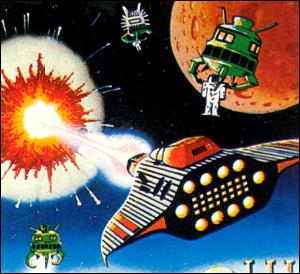
DEFENDA, for the Spectrum, is hardly earth-shaking and it would barely register on the Richter scale of software, as it is yet another version of the well-worn arcade favourite Defender.
Interstella, the company which manufactures the game, may be new to the software scene and the Spectrum but that is no excuse for producing a game which appears outdated and uninventive.
You will experience a sudden attack of déjà vu as your ship appears above an alien landscape. It can move in all directions on the screen. As it moves horizontally the landscape below it scrolls across the screen and the aliens materialise, ready to kill or be killed.
As in the arcade version, the alien ships have a habit of picking up refugees who are on the ground. If you shoot an alien which is carrying a refugee the little figure will fall to the ground and die. It is also your job to rescue refugees who look as though they may meet with a sticky end.
The game is joystick-compatible but it is scarcely worth using such an aid as the keyboard is ample for earning points. Neither is it worth moving through to the depths of skill in the game as the graphics do not become any more than ordinary. It can be obtained from Interstella Software, Brockenhurst.
| DEFENDA | Memory: 48K | Price: £5.50 | Joystick: Interface Two, Kempston | Gilbert Factor: 2 |
THE FIRST THREE in a series of Games for Girls promised by CCS do not augur well for the rest of the line. Apart from a tenuous link with show jumping in one game, and a heroine rather than a hero in another, it is difficult to see where the special appeal for the female half of the cassette-buying public lies, unless simplicity and slowness are intended to be the main selling-point.
The intentions of CCS in producing the series may have been well-meaning but the overall quality of the games and the patronising tone of the inserts could lay the company open to charges of sexism.
Hicksted is designed as a simulation of a show jumping event but neither the graphics nor the laborious question-and-answer process which has to take place before the game can start convey any sense of excitement. The control keys are placed awkwardly and a great deal of practice is needed before the path of the horse loses its resemblance to a bull on the rampage rather than a well-trained steed.
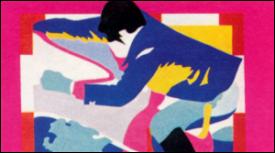
The second side of the tape offers a mathematical version which is a good deal more entertaining than the original, since the primitive graphics and movement do not matter so much. The object is to take the jumps by answering mathematics questions correctly; you can choose to be tested on multiplication, division, addition and subtraction, with several levels of difficulty for each. A time factor adds a challenge and the game provides an effective form of maths drill.
The insert for Diamond Quest makes the dubious claim that the colourful graphics and absence of monsters make it specially suitable for girls. In fact it is a straightforward graphics adventure, in which the object is to collect four keys and find your way to a Golden Palace where a treasure is to be found. On your way you encounter unpleasant creatures such as a hulk, some bloodthirsty bats, wild lions and swarming mosquitoes, and you can replenish your strength by eating food or booking into a hotel.
The game features simple one-character commands, a variety of locations which have little to distinguish them from each other apart from their names, and a series of battles which take the form of your enemy's energy level and your own ticking away numerically before your eyes.
There are several levels of difficulty and if you have never played an adventure game previously, the ease of movement from one scenario to another might prove an attractive introduction to the genre.
In other respects the game does not have the sophistication or mind-taxing qualities of many other adventures on the market.
Jungle Adventure features Bobo, a young African girl making her way from school to her home in the jungle. The game starts at school, where Bobo must try to win prizes such as an egg, a hamburger, a coconut or a book with which she will later bribe the creatures she meets in the jungle. The prizes are won by a Mastermind-style guessing game which, although scarcely original, is entertaining.
The second stage of the game, in which Bobo must make her way past a variety of creatures which become visible only when she bumps into them, is less successful, especially as the placing of the keys makes it extremely difficult to complete the journey. An unfortunate slip by which Bobo is referred to as he rather than she when she falls into the lake is in this context a serious fault.
| HICKSTED/MATHSTED | Memory: 48K | Price: £5 | Joystick: Kempston | Gilbert Factor: 5 |
| DIAMOND QUEST | Memory: 48K | Price: £5 | Gilbert Factor: 4 | |
| JUNGLE ADVENTURE | Memory: 48K | Price: £6 | Gilbert Factor: 4 |
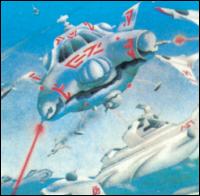
YOUR HELICOPTER is poised on the deck of a battleship ready to take off and destroy the nuclear reactor which is endangering life in Blue Thunder for the 48K Spectrum.
You must fly your whirlybird through enemy terrain, attacked by the gun installations on land and sea. Once through that murderous onslaught you have to gain access to the nuclear reactor which is beneath the waves and fire your guns to make it explode. If you are not quick enough you will be destroyed.
The game has a simple appearance but the animated graphics are well-produced and are a major selling-point. The detail is so complete that the helicopter rotor blades seem to increase speed when it is stationary, hovering opposite a target.
The only difficulty a player could experience is completing one mission, let alone several. Your small ammunition, which looks like full stops coming from the helicopter, makes it difficult to judge whether you will hit anything or not.
Blue Thunder is original and entertaining. It can be obtained from Richard Wilcox Software, West Midlands.
| BLUE THUNDER | Memory: 48K | Price: £5.95 | Joystick: Kempston | Gilbert Factor: 6 |
IF YOU are an avid bridge player you will know that it is often very difficult to find three other people to play what is perhaps the most exciting and complex of card games. Unless you go to classes it is also difficult to have the opportunity to learn more advanced play without upsetting expert partners or losing a little cash.
CP Software has come to the rescue with two programs designed to meet the problems - Bridge Player and Bridge Tutor - Advanced.
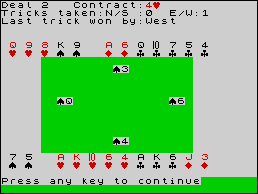
Both programs use the Acol bidding system and accept most conventional bids, including the Stayman and Blackwood conventions. Full cassette notes supplement the programs and give comprehensive instructions on the playing method.
In Bridge Player it is assumed that you have some idea of the basics of bridge playing. The computer will shuffle and deal a new random hand each time and you can then elect either to bid your hand in the normal way, following it with the game, or you can choose to see all four hands, decide the contract and declarer, and then play out the contract. When the play is completed, the score is displayed with details of vulnerability. If you did not make the contract, the program even plays the Dead March in sympathy. You can review and replay the hand if you wish, though a replayed hand will not count towards your score.
Each hand can be printed out if you have a printer and general operating procedure is very simple, enabling you to get straight into the play. Remember, every hand is new, so you can go back to Bridge Player time after time.
Bridge Tutor - Advanced offers 40 pre-dealt hands for the more competent player. Each hand must be loaded separately after you have loaded the main program, so do not forget to follow the instructions on-screen - the prompts are very helpful.
The play is similar and will allow only the recommended card to be put down. After the hand has been played, there is a very full explanation of the bidding and play it was designed to illustrate. You may go direct to the explanation at any time or replay the hand.
Both programs are well-designed, with clear graphics using a green table. They are of a high quality and will be of great use to players who want to improve their game.
| BRIDGE PLAYER | Memory: 48K | Price: £8.95 | Gilbert Factor: 8 |
| BRIDGE TUTOR (ADVANCED) | Memory: 16K | Price: £5.95 | Gilbert Factor: 8 |
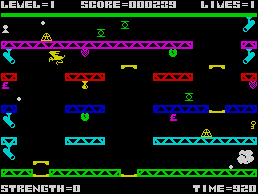
ACCORDING to Smiffy, a character in 1994, a new game for the Spectrum, George Orwell chose correctly with his Big Brother theory but had the year wrong -it should have been 1994.
Apart from that there is nothing remotely interesting or startling in the game. It looks as if manufacturer Visions has jumped on the Manic Miner bandwagon. Smiffy has to climb a structure of platforms which are being bombarded continually by alien creatures. He has to climb through the nightmare world and attack the central computer which, in the best Tronic traditions, is holding the world in its metallic grasp. Switching off the computer will win the game.
The screen is filled with a series of exotic blips and blobs which could be anything. If the scenario is a nightmare, the instructions are worse, as you have to grope round the keyboard to find which keys to press.
The high score table and paragraph giving details of the game may be futuristic in style but they are also illegible. The 'computer-style' characters are too heavy and it is difficult to distinguish between numbers and characters on the high score table.
There is nothing to distinguish the program from any of the others which resemble Manic Miner. If you are new to computers, however, and have not seen Manic Miner you may like 1994.
The game is produced by Visions, London.
| 1994 | Memory: 48K | Price: £9.95 | Gilbert Factor: 4 |
THE CRICKET season has begun so it is a good idea to have a program which will keep track of players' averages.
Cricket Averages for the 48K Spectrum will keep track of all the details you will need to keep up-to-date with your home team and if you are managing a local club you will be able to organise play round the results produced by the program.
Names of players, batting and bowling must first be entered and that can then be sorted by the computer into alphabetical and numerical order. That will take about two minutes, which is extremely slow for the amount of data which you can include in the program.
You will then have a list of players and their averages which you can store on tape. Once you have created a file, amending it is easy. All you have to do is push the correct menu option and the computer will prompt you for the information which is necessary.
Once you have entered the data you will be able to look at individual player records, bowling averages and catches taken. The batting averages of each player or all the team can also be accessed.
For the cricket enthusiast the tape will prove invaluable. More details of Cricket Averages can be obtained from Spartan CC, Surrey.
| CRICKET AVERAGES | Memory: 48K | Gilbert Factor: 6 |